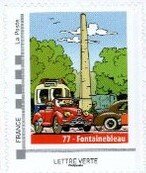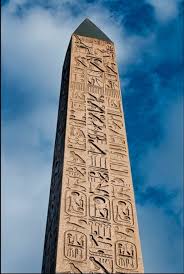Stamp: 77 Fontainebleau (France- Personalized stamps 2021)
77 Fontainebleau (France- Personalized stamps 2021)
21 June (France- Personalized stamps ) within release Collector : Nationale 7. Paris to Lyon goes into circulation Stamp 77 Fontainebleau face value Lettre No Face Value
| Stamp 77 Fontainebleau in catalogues | |
|---|---|
| Colnect codes: | Col: FR 202-COL14-3 |
Stamp is square format.
Holiday Route pre Motorway.Also in the issue Collector : Nationale 7. Paris to Lyon:
- Stamp - 03 Lapalisse face value Lettre;
- Stamp - 45 Fontenay-sur-Loing face value Lettre;
- Stamp - 58 Nevers face value Lettre;
- Stamp - 58 Pouilly-sur-Loire face value Lettre;
- Stamp - 69 Tassin-la-Demi-Lune face value Lettre;
- Stamp - 69/42 Col-de-Pin-Bouchain face value Lettre;
- Stamp - 77 Fontainebleau face value Lettre;
- Booklet - Nationale 7. Paris to Lyon face value 8*Lettre;
- Stamp - Notre Dame de Paris km0 face value Lettre;
Stamp 77 Fontainebleau it reflects the thematic directions:
A car is a wheeled, self-powered motor vehicle used for transportation and a product of the automotive industry. Most definitions of the term specify that cars are designed to run primarily on roads, to have seating for one to eight people, to typically have four wheels with tyres, and to be constructed principally for the transport of people rather than goods. The year 1886 is regarded as the birth year of the modern car. In that year, German inventor Karl Benz built the Benz Patent-Motorwagen. Cars did not become widely available until the early 20th century. One of the first cars that was accessible to the masses was the 1908 Model T, an American car manufactured by the Ford Motor Company. Cars were rapidly adopted in the United States of America, where they replaced animal-drawn carriages and carts, but took much longer to be accepted in Western Europe and other parts of the world.
A monument is a type of structure that was explicitly created to commemorate a person or event, or which has become relevant to a social group as a part of their remembrance of historic times or cultural heritage, due to its artistic, historical, political, technical or architectural importance. Examples of monuments include statues, (war) memorials, historical buildings, archaeological sites, and cultural assets. If there is a public interest in its preservation, a monument can for example be listed as a UNESCO World Heritage Site. The Palgrave Encyclopedia of Cultural Heritage and Conflict gives the next definition of monument:
An obelisk is a tall, slender, tapered monument with four sides and a pyramidal or pyramidion top. Originally constructed by Ancient Egyptians and called tekhenu, the Greeks used the Greek term obeliskos to describe them, and this word passed into Latin and ultimately English. Though William Thomas used the term correctly in his Historie of Italie of 1549, by the late sixteenth century (after reduced contact with Italy following the excommunication of Queen Elizabeth), Shakespeare failed to distinguish between pyramids and obelisks in his plays and sonnets. Ancient obelisks are monolithic and consist of a single stone; most modern obelisks are made of several stones.
A road is a thoroughfare for the conveyance of traffic that mostly has an improved surface for use by vehicles (motorized and non-motorized) and pedestrians. Unlike streets, whose primary function is to serve as public spaces, the main function of roads is transportation.
Tourism is travel for pleasure or business; also the theory and practice of touring, the business of attracting, accommodating, and entertaining tourists, and the business of operating tours. Tourism may be international, or within the traveller's country. The World Tourism Organization defines tourism more generally, in terms which go "beyond the common perception of tourism as being limited to holiday activity only", as people "traveling to and staying in places outside their usual environment for not more than one consecutive year for leisure, business and other purposes". Tourism can be domestic or international, and international tourism has both incoming and outgoing implications on a country's balance of payments. Today, tourism is a major source of income for many countries, and affects the economy of both the source and host countries, in some cases being of vital importance.
A vehicle (from Latin: vehiculum) is a mobile machine that transports people or cargo. Typical vehicles include wagons, bicycles, motor vehicles (motorcycles, trucks, buses), railed vehicles (trains, trams), watercraft (ships, boats), aircraft and spacecraft. Land vehicles are classified broadly by what is used to apply steering and drive forces against the ground: wheeled, tracked, railed or skied. ISO 3833-1977 is the standard, also internationally used in legislation, for road vehicles types, terms and definitions.






